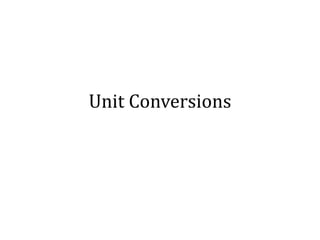
2 2 unit conversions
- 2. Purpose • Lots of different units exist for the same measurement: – e.g. Length units • Foot, cubit, meter, centimeter, hand, league, etc. • You need to be able to convert between different units, and for most conversions a method called dimensional analysis will work.
- 3. Dimensional Analysis • With dimensional analysis one takes the number they start with and multiplies it by a conversion factor to change the units. 𝐺𝑖𝑣𝑒𝑛 × 𝑐𝑜𝑛𝑣𝑒𝑟𝑠𝑖𝑜𝑛 𝑓𝑎𝑐𝑡𝑜𝑟 = 𝑎𝑛𝑠𝑤𝑒𝑟 𝑤𝑖𝑡ℎ 𝑛𝑒𝑤 𝑢𝑛𝑖𝑡
- 4. Conversion Factors relate the old and new unit • To make a conversion between units, you need to know the relationship between the units. For example, 12 in (inches) is equal to 1 ft (foot). • The relationship can be set-up as a fraction known as a conversion factor: 12 𝑖𝑛 1 𝑓𝑡 𝑜𝑟 1 𝑓𝑡 12 𝑖𝑛 • Note: While there are two different ways to make the fraction, you will only use one when making a conversion depending on the units you start with.
- 5. Dimensional Analysis is a process • Follow the process and it should not be too difficult – Get ready for the calculation 1. Identify what you are given and asked for 2. Identify the relationship between the original and new units. 3. Set-up the relationship as a fraction – Calculation 1. Begin the calculation with the number you want to convert 2. Multiply it by the fraction that relates the units 3. Solve the numerical calculation 4. Cross out and solve the units 5. Check your answer
- 6. Example – get set-up • How many feet are equivalent to 36 inches? 1. Identify what you are given and asked for • We are given: – 36 inches • We are asked for: – How many feet? 2. Identify the relationship between the original and new units. We are converting from inches to feet. The relationship is: 1 foot = 12 inches 3. Set-up the relationship as a fraction • We already established that 1 foot = 12 inches. We can make two fractions with this. 1 𝑓𝑜𝑜𝑡 12 𝑖𝑛𝑐ℎ𝑒𝑠 𝑜𝑟 12 𝑖𝑛𝑐ℎ𝑒𝑠 1 𝑓𝑜𝑜𝑡
- 7. Example – the calculation • How many feet are equivalent to 36 inches? 1. We write down the given quantity. 36 𝑖𝑛𝑐ℎ𝑒𝑠 … 2. We multiply our given quantity by one of the conversion factors. If the given unit is in the numerator we use the fraction with that same unit in the denominator. 36 𝑖𝑛𝑐ℎ𝑒𝑠 × 1 𝑓𝑜𝑜𝑡 12 𝑖𝑛𝑐ℎ𝑒𝑠 = 3. Solve the numerical calculation 36 × 1 12 = 36 𝑥 1 12 = 3 4. Solve the units 𝑖𝑛𝑐ℎ𝑒𝑠 × 𝑓𝑜𝑜𝑡 𝑖𝑛𝑐ℎ𝑒𝑠 = 𝑖𝑛𝑐ℎ𝑒𝑠 × 𝑓𝑜𝑜𝑡 𝑖𝑛𝑐ℎ𝑒𝑠 = 𝑓𝑜𝑜𝑡 Put the number and units together for your answer 3 feet 5. Check your answer
- 8. Why are we using this method? • You may be thinking that this is making it more complicated than it should be. This method helps to ensure you do it correctly each time whether it is a simple problem or more complex one.
- 9. Pause and Practice • What is the mass in kilograms (kg) of someone with a weight of 180 pounds (lb) if 1 kg = 2.205 lb?
- 10. Pause and Practice Answers • What is the mass in kilograms (kg) of someone with a weight of 180 pounds (lb) if 1 kg = 2.205 lb? – Given: 180 pounds – Asked for: Mass in kilograms – Relationship: 1 kg = 2.205 lb – Solution: 180 𝑙𝑏 × 1 𝑘𝑔 2.205 𝑙𝑏 = 81.6 𝑘𝑔
- 11. Now try the exercise. • Please write down your work on scratch paper. • Do not be afraid of units you have never encountered. You can still do the conversions. • Make sure you have your conversion factor set-up correctly to cancel out the units properly.